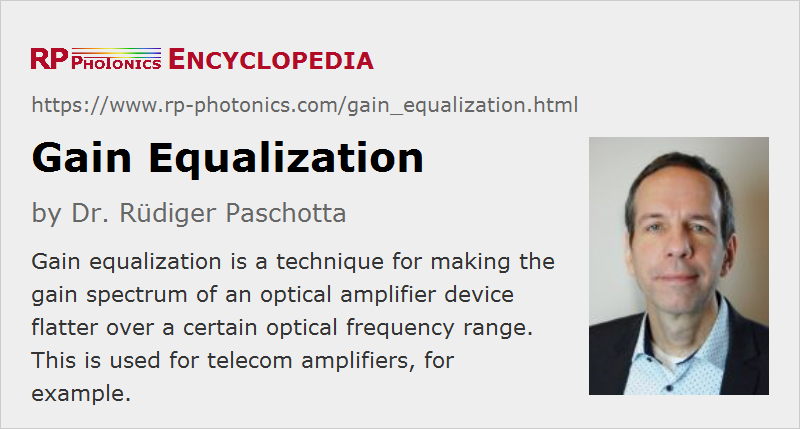Gain Equalization
Definition: a technique for making the gain spectrum of an optical amplifier device flatter over a certain optical frequency range
Alternative term: gain flattening
Author: Dr. Rüdiger Paschotta
Cite the article using its DOI: https://doi.org/10.61835/2n0
Get citation code: Endnote (RIS) BibTex plain textHTML
The optical gain e.g. from a fiber amplifier has some dependence on the wavelength, which can be disturbing in certain applications. For example, in optical fiber communications with wavelength division multiplexing, the wavelength dependence of the gain can unbalance the optical powers in the transmitted channels. Therefore, it is common to apply methods for gain equalization, also called gain flattening. There are various technological options:
- For a given kind of active fiber, the shape of the gain spectrum can often be optimized simply by adjusting the average excitation level of the laser-active ions. (This holds for amplifier transitions in quasi-three-level laser gain media, as are most common in the area of fiber amplifiers.) The excitation level can be adjusted e.g. by varying the pump power or the length of the active fiber.
- The material composition of the fiber core can be optimized. For example, silica fibers can be optimized with various codopants, and fluoride fibers can offer a fairly flat gain spectrum.
- Amplifier fibers of different glass compositions can be combined in an amplifier chain to obtain a wideband hybrid amplifier.
- Another approach is a split-band amplifier, where a wavelength-dependent splitter distributes the signal content over two or more different fiber amplifiers, and another wavelength-dependent fiber coupler serves to recombine the spectral components.
- One can use a Raman amplifier, where the gain spectrum can be tailored with a proper combination of pump sources at different wavelengths [7].
- Optical filters (gain flattening filters) can be used, which have higher losses in wavelength regions where the gain is higher. Such filters are often based on some kind of fiber Bragg gratings (long-period gratings, slanted gratings or chirped gratings), although various other types of filters have been demonstrated.
Gain Equalization with Gain Flattening Filters
It is common to first apply some method to get a roughly flat gain spectrum – for example, optimizing the length of an erbium-doped fiber –, and then do the fine tuning with some gain flattening filter.
For the optimization of a fiber amplifier with flattening filters, various aspects need to be taken into account. In particular:
- One can attenuate too strong signals after the amplifier. That has a minimal impact on the noise performance, but is not power-efficient.
- Alternatively, one may apply attenuation at the input end. This is far more power-efficient, but the noise figure of the system will be increased: attenuating weak signals is more problematic concerning introduced quantum noise.
- A better trade-off between power efficiency and noise figure can be achieved with a dual-stage amplifier design, where the gain flattening filter is placed between the stages.

Case Study: Erbium-doped Fiber Amplifier for Multiple Signals
We optimize an amplifier for equal output powers of signals spanning a substantial wavelength range. There is a trade-off between power efficiency and noise performance.

More to Learn
Encyclopedia articles:
Suppliers
Bibliography
| [1] | K. Inoue et al., “Tunable gain-equalization using a Mach–Zehnder optical filter in multistage amplifiers”, IEEE Photon. Technol. Lett. 3, 718 (1991); https://doi.org/10.1109/68.84463 |
| [2] | S. F. Su et al., “Gain equalization in multiwavelength lightwave systems using acousto-optic tunable filters”, IEEE Photon. Technol. Lett. 4, 269 (1992); https://doi.org/10.1109/68.122389 |
| [3] | R. Kashyap et al., “Wavelength flattened saturated erbium amplifier using multiple side-tap Bragg gratings”, Electron. Lett. 29 (11), 1025 (1993); https://doi.org/10.1049/el:19930685 |
| [4] | B. Clesca et al., “1.5 μm fluoride-based fiber amplifiers for wideband multichannel transport networks”, Opt. Fiber Technol. 1, 135 (1995); https://doi.org/10.1006/ofte.1995.1004 |
| [5] | A. M. Vengsarkar et al., “Long-period fiber-grating-based gain equalizers”, Opt. Lett. 21 (5), 336 (1996); https://doi.org/10.1364/OL.21.000336 |
| [6] | N. Park et al., “High-power Er–Yb-doped fiber amplifier with multichannel gain flatness within 0.2 dB over 14 nm”, IEEE Photon. Technol. Lett. 8, 1148 (1996); https://doi.org/10.1109/68.531818 |
| [7] | Y. Emori et al., “100 nm bandwidth flat-gain Raman amplifiers pumped and gain-equalized by 12-wavelength-channel WDM laser diode unit”, Electron. Lett. 35, 1355 (1999); https://doi.org/10.1109/OFC.1999.766052 |
| [8] | M. Harurnoto et al., “Gain-flattening filter using long-period fiber gratings”, J. Lightwave Technol. 20 (6), 1027 (2002); https://doi.org/10.1109/JLT.2002.1018814 |
| [9] | Ik-Bu Sohn et al., “Gain flattened and improved EDFA using microbending long-period fibre gratings”, Electron. Lett. 38 (22), 1324 (2002); https://doi.org/10.1049/el:20020915 |
| [10] | G. Qin, R. Jose and Y. Ohishi, “Design of ultimate gain-flattened O-, E-, and S+ C+ L ultrabroadband fiber amplifiers using a new fiber Raman gain medium”, J. Lightwave Technol. 25 (9), 2727 (2007) |
Questions and Comments from Users
Here you can submit questions and comments. As far as they get accepted by the author, they will appear above this paragraph together with the author’s answer. The author will decide on acceptance based on certain criteria. Essentially, the issue must be of sufficiently broad interest.
Please do not enter personal data here; we would otherwise delete it soon. (See also our privacy declaration.) If you wish to receive personal feedback or consultancy from the author, please contact him, e.g. via e-mail.
By submitting the information, you give your consent to the potential publication of your inputs on our website according to our rules. (If you later retract your consent, we will delete those inputs.) As your inputs are first reviewed by the author, they may be published with some delay.

 optical amplifiers
optical amplifiers

Connect and share this with your network:
Follow our specific LinkedIn pages for more insights and updates: